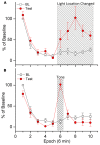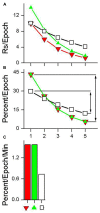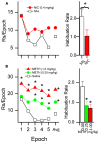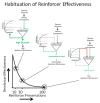Habituation of reinforcer effectiveness
- PMID: 24409128
- PMCID: PMC3885986
- DOI: 10.3389/fnint.2013.00107
Habituation of reinforcer effectiveness
Abstract
In this paper we propose an integrative model of habituation of reinforcer effectiveness (HRE) that links behavioral- and neural-based explanations of reinforcement. We argue that HRE is a fundamental property of reinforcing stimuli. Most reinforcement models implicitly suggest that the effectiveness of a reinforcer is stable across repeated presentations. In contrast, an HRE approach predicts decreased effectiveness due to repeated presentation. We argue that repeated presentation of reinforcing stimuli decreases their effectiveness and that these decreases are described by the behavioral characteristics of habituation (McSweeney and Murphy, 2009; Rankin etal., 2009). We describe a neural model that postulates a positive association between dopamine neurotransmission and HRE. We present evidence that stimulant drugs, which artificially increase dopamine neurotransmission, disrupt (slow) normally occurring HRE and also provide evidence that stimulant drugs have differential effects on operant responding maintained by reinforcers with rapid vs. slow HRE rates. We hypothesize that abnormal HRE due to genetic and/or environmental factors may underlie some behavioral disorders. For example, recent research indicates that slow-HRE is predictive of obesity. In contrast ADHD may reflect "accelerated-HRE." Consideration of HRE is important for the development of effective reinforcement-based treatments. Finally, we point out that most of the reinforcing stimuli that regulate daily behavior are non-consumable environmental/social reinforcers which have rapid-HRE. The almost exclusive use of consumable reinforcers with slow-HRE in pre-clinical studies with animals may have caused the importance of HRE to be overlooked. Further study of reinforcing stimuli with rapid-HRE is needed in order to understand how habituation and reinforcement interact and regulate behavior.
Keywords: ADHD; behavioral regulation; dopamine; drug addiction; obesity; operant conditioning; psychomotor stimulant; sensory reinforcement.
Figures







Similar articles
-
Nicotine and methamphetamine disrupt habituation of sensory reinforcer effectiveness in male rats.Exp Clin Psychopharmacol. 2014 Apr;22(2):166-75. doi: 10.1037/a0034741. Exp Clin Psychopharmacol. 2014. PMID: 24708147 Free PMC article.
-
Operant sensation seeking in the mouse.J Vis Exp. 2010 Nov 10;(45):2292. doi: 10.3791/2292. J Vis Exp. 2010. PMID: 21113110 Free PMC article.
-
Sensitization and habituation regulate reinforcer effectiveness.Neurobiol Learn Mem. 2009 Sep;92(2):189-98. doi: 10.1016/j.nlm.2008.07.002. Epub 2008 Aug 19. Neurobiol Learn Mem. 2009. PMID: 18674628
-
Motivational views of reinforcement: implications for understanding the behavioral functions of nucleus accumbens dopamine.Behav Brain Res. 2002 Dec 2;137(1-2):3-25. doi: 10.1016/s0166-4328(02)00282-6. Behav Brain Res. 2002. PMID: 12445713 Review.
-
Behavioral functions of nucleus accumbens dopamine: empirical and conceptual problems with the anhedonia hypothesis.Neurosci Biobehav Rev. 1997 May;21(3):341-59. doi: 10.1016/s0149-7634(96)00017-6. Neurosci Biobehav Rev. 1997. PMID: 9168269 Review.
Cited by
-
Impaired P1 Habituation and Mismatch Negativity in Children with Autism Spectrum Disorder.J Autism Dev Disord. 2020 Feb;50(2):603-616. doi: 10.1007/s10803-019-04299-0. J Autism Dev Disord. 2020. PMID: 31728809
-
Dopamine receptor DOP-4 modulates habituation to repetitive photoactivation of a C. elegans polymodal nociceptor.Learn Mem. 2016 Sep 15;23(10):495-503. doi: 10.1101/lm.041830.116. Print 2016 Oct. Learn Mem. 2016. PMID: 27634141 Free PMC article.
-
Attention to novelty versus repetition: Contrasting habituation profiles in Autism and Williams syndrome.Dev Cogn Neurosci. 2018 Jan;29:54-60. doi: 10.1016/j.dcn.2017.01.006. Epub 2017 Jan 19. Dev Cogn Neurosci. 2018. PMID: 28130077 Free PMC article.
-
Outcome devaluation by specific satiety disrupts sensory-specific Pavlovian-to-instrumental transfer.Front Behav Neurosci. 2022 Nov 9;16:983480. doi: 10.3389/fnbeh.2022.983480. eCollection 2022. Front Behav Neurosci. 2022. PMID: 36439968 Free PMC article.
-
Evaluating cognitive and motivational accounts of greater reinforcement effects among children with attention-deficit/hyperactivity disorder.Behav Brain Funct. 2015 Apr 29;11:20. doi: 10.1186/s12993-015-0065-9. Behav Brain Funct. 2015. PMID: 25926127 Free PMC article.
References
-
- American Psychiatric Association. (2013). Diagnostic and Statistical Manual of Mental Disorders. Washington, DC: American Psychiatric Association
-
- Aoyama K., McSweeney F. K. (2001). Habituation may contribute to within-session decreases in responding under high-rate schedules of reinforcement. Anim. Learn. Behav. 29 79–9110.3758/BF03192817 - DOI
-
- Appel J. B, Hurwitz H. M. B. (1959). Studies in light-reinforced behavior: IV. Effects of apparatus familiarization. Psychol. Rep. 5 355–35610.2466/pr0.1959.5.3.355 - DOI
-
- Barkley R. A. (1997). Defiant Children: A Clinician’s Manual for Assessment and Parent Training. New York, NY: The Guilford Press
Publication types
Grants and funding
LinkOut - more resources
Full Text Sources
Other Literature Sources

